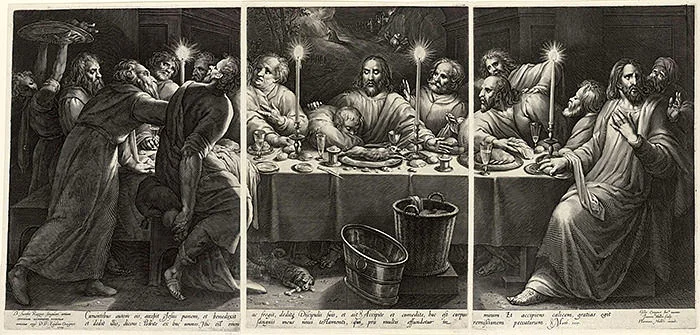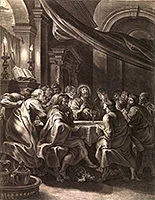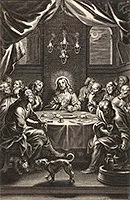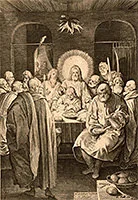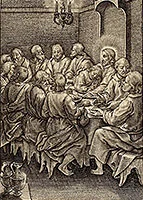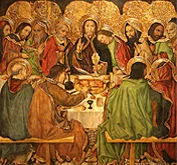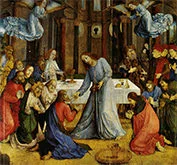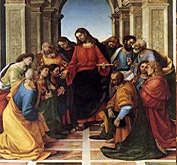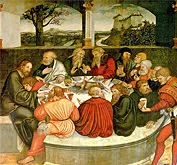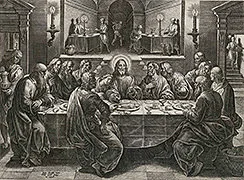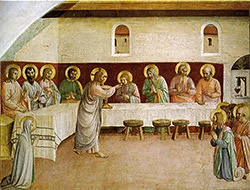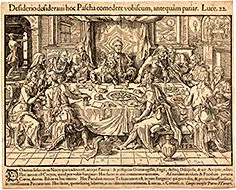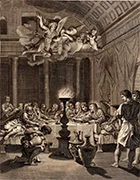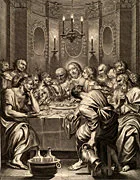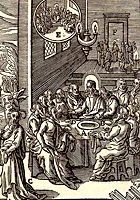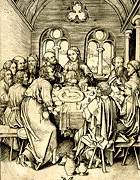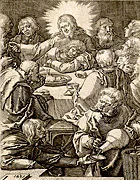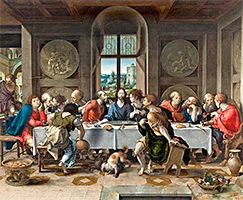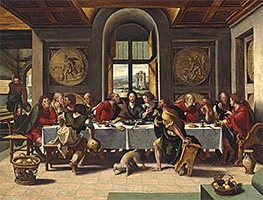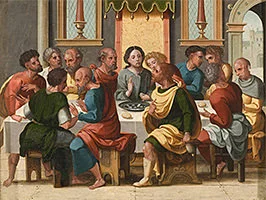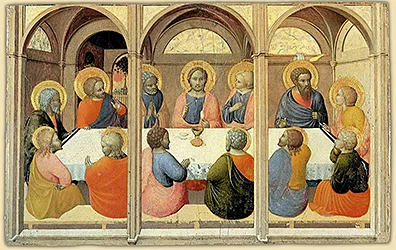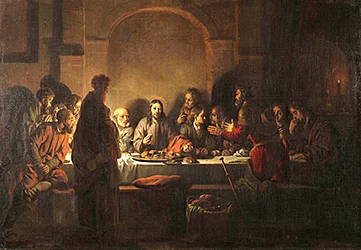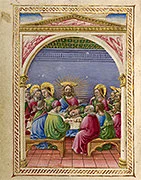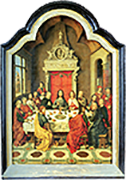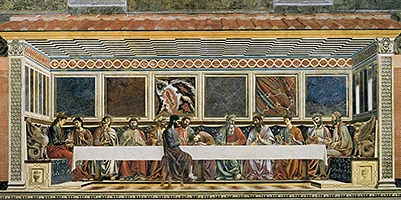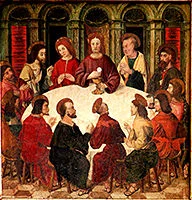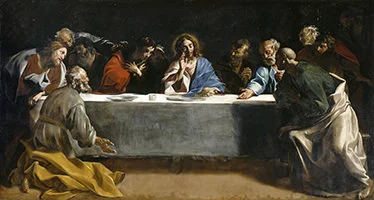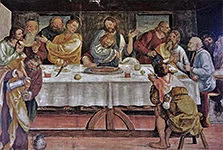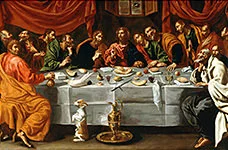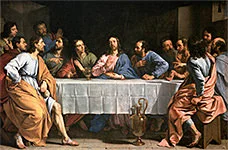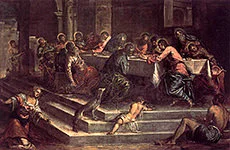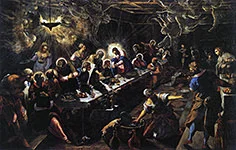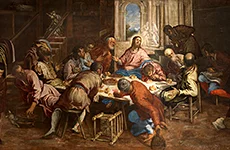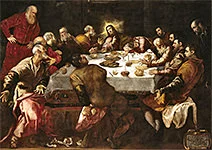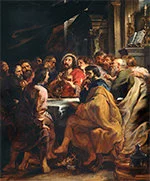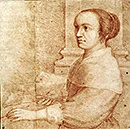The Art World Commemorates Peter
— Album 10 of 17 Photo Albums —
Warren Camp’s presentation of 550 famous “Peter” works of art includes historic paintings, frescoes, stained glass, etchings, sculptures, engravings, and other artwork monuments. They come from the Gothic (1100–1400), High Renaissance, Baroque, Rococo, Neoclassical, and Romantic (1800s) eras.
All are popular works, designed and created by celebrated artists, many of whom you’ll likely recognize, including Rembrandt, Raphael, Michelangelo, El Greco, Da Vinci, Masaccio, Huret, Galle, Tissot, Botticelli, Dürer, Rubens, and many more. They’ll bring back recollections of your “Art History 101” classes, using Janson’s History of Art textbook.
Whether depicting “Cephas,” “Petrus,” “Simon,” “Simeon,” “Simon Bar-Jonah,” “Simon Peter,” “The Rock,” “Peter,” “Apostle Peter,” or “Saint Peter,” the enlarged images of this acclaimed Bible figure come with factual and enlightening details: the artist’s bio; when each work was created; where it can be seen; applicable Bible passages; background and highlights of each work; and photo sources with copyright notices.
To appreciate the impact that Peter had on numerous art-world masters, be sure to click each thumbnail to enlarge it.
• These photo albums complement the Bible-study commentaries Warren has written for “1st and 2nd Peter,” found here.
…
Album 1 (Peter, alone) | Album 2 | Album 3 | Album 4 | Album 5
Album 6 | Album 7 | Album 8 | Album 9 | Album 10 | Album 11
Album 12 | Album 13 | Album 14 | Album 15 | Album 16 | Album 17
Album topics are shown at the [ ⇓ bottom ⇓ ] of each page.
Jesus’ Last Supper — Part 2 of 4
136 “Last Supper” Masterpieces in Four Photo Albums
Includes Galle, Dürer, Wierix, Fra Angelico, Tintoretto, Lanfranco, Crivelli, Muller, Huret, Cranach, and more
Slide 1 — Click to enlarge all three engraved plates and read their detailed captions.
Johannes Muller, 1594, after Gillis Coingnet, engraved triptych on paper
See more “Last Supper” masterpieces in Warren Camp’s Album 11 and Album 12.
- 1. “The Last Supper,” engraved triptych on paper, by Johannes Harmensz. Muller, 1594, after Gillis Coignet
Joannes Harmensz. Muller’s “The Last Supper” is a rare triptych (a painting or engraving in three parts) from 1594 that’s presented by Riksmuseum Amsterdam… See hundreds more Last Supper artwork varieties from Rijksmuseum Amsterdam in addition to its numerous Last Supper engraved prints.
Enlargements of this triptych’s panels include sharp details and footer captions: Panel 1, … Panel 2, … Panel 3.
In this “betrayal scene,” all of the Twelve are at the dining table, with Jesus at the center. Traditionally, the young apostle, John, is placed to the right of Christ while Peter is to the viewer’s left. However, Johannes Muller (also known as Jan Harmensz. Muller) notably reversed that order. Herein, Jesus has just informed his disciples that one of them will betray him, a prophecy fulfilled by Judas who the artist chose to intentionally identify, as shown above in Panel #1.
What happened in the upper room during the Last Supper? “The events that occurred in the ‘upper room,’ also known as the ‘Cenacle,’ are described in Matthew 26:1–29, Mark 14:12–25, Luke 22:7–20, and John 13:1–38. During these last hours that Jesus spent with His beloved friends, He ate with them, instituted the New Covenant in His blood, gave them last-minute instructions and encouragement, and prayed His “high priestly prayer” over them. Then He went out to face the sorrow, betrayal, rejection, and death for which He had come into the world.”[1]
… Height: 37 in. (938 mm), width: 17 1/2 in. (446 mm)
… Photo source, license, attribution, museum details, and image enlargement: Rijksmuseum Amsterdam
… The artist’s short biography; his other works of art
Return to “Peter Masterpieces” album’s opening page or to the top of this page or open the next album.
- 2. “The Last Supper,” engraved on paper, Boëtius Adamsz. Bolswert, 1630–1633
Boetius à Bolswert (also Botius Adamsz Bolswert, Bodius; “was a renowned copper-plate engraving engraver of Friesland, Netherlands origin. In his time, the paintings of Peter Paul Rubens called forth new endeavors by engravers to imitate or reproduce the breadth, density of mass, and dynamic illumination of those works.
This Dutch artist was an important figure in this movement, not least because he was the elder brother and instructor of the engraver Schelte à Bolswert, whose reproductions of Rubens’ landscapes were most highly esteemed in their own right.”[1] The thumbnail image to the right shows Ruben’s 1631–1632 Last Supper painting that Bolswert copied. Rubens created it as part of an Antwerp church altarpiece. Other than Jesus, the most prominent figure in each artwork is Judas; he holds his right hand to his mouth with his eyes avoiding direct contact with the other figures in the painting, thereby creating a nervous expression. Learn more about that painting and see its enlargement by opening Warren Camp’s Album 9, slide 19.
See hundreds more Last Supper artwork varieties from Rijksmuseum Amsterdam in addition to its numerous Last Supper engraved prints.
… Height: 26 in. (658 mm), width: 19 1/2 in. (497 mm)
… Photo source, license, attribution, museum details, and image enlargement: Rijksmuseum Amsterdam
… The artist’s short biography; his other works of art
Return to “Peter Masterpieces” album’s opening page or to the top of this page or open the next album. - 3. “The Last Supper,” book illustration, engraved on paper, Cornelis Galle, 1650–1653
Cornelis Galle the Elder (1576–1650), a younger son of Philip Galle, was born at Antwerp, Belgium and was taught engraving by his father.
Here, in this “Last Supper” book illustration (after a design by Abraham van Diepenbeek), as wine is about to be poured for many, this Dutch artist places haloed Christ in the center of this masterpiece, sitting with his disciples around a circular table that was used for his Last Supper. Holding a loaf of bread in his hand while looking upward, he prepares to tell the Twelve that one of them will betray him to Jewish leaders. In the foreground, we feel the tension when we see a dog and cat confront each other at Judas’ feet.
The Last Supper was the final meal that Jesus shared with his apostles in Jerusalem before his crucifixion. Paul’s first epistle, which he wrote to the Corinthian church body, contains the earliest known mention of the Last Supper. Read this very personal passage in 1 Cor. 11:23–26.
Hundreds more Last Supper artwork varieties are on Rijksmuseum page; find numerous Last Supper engraved prints.
An excellent video — “Apostle Peter and the Last Supper” — portrays Peter in jail, telling his story of Jesus to a young Roman guard; it includes a very detailed account of the Last Supper, which delivers a powerful “faith” message.
… Height: 11 3/4 in. (300 mm), width: 7 3/4 in. (200 mm)
… Photo source, license, attribution, museum details, and image enlargement: Rijksmuseum Amsterdam
… The artist’s short biography; his other works of art
Return to “Peter Masterpieces” album’s opening page or to the top of this page or open the next album.
- 4. “The Last Supper,” engraved on paper, Nicolaes de Bruyn, 1618, after Hendrick Goltzius
Nicolaes de Bruyn (1571–1656), a Flemish engraver, painter, and dealer, was registered in 1601 as a master in Antwerp’s Guild of St Luke. After a 1598 design by Flemish artist Hendrick Goltzius (that Warren Camp’s Album 9 highlights in its 25th image), Nicolaes engraved this Last Supper as part of his Passion Series. It’s plate one of twelve in that series. His “NDB” monogram can be seen in the lower-left corner.
As a seated disciple pours wine from a metal pitcher (front-right), this Dutch artist presents Judas (front-left) on his feet with his bag of coins in hand. Opposite him, haloed Christ, in the center of this masterpiece, casts his eyes directly on Judas’ face as the betrayer is about to depart the upper room.
What happened in the upper room? “The events that occurred in the ‘upper room,’ also known as the ‘Cenacle,’ are described in Matthew 26:1–29, Mark 14:12–25, Luke 22:7–20, and John 13:1–38. During these last hours that Jesus spent with His beloved friends, He ate with them, instituted the New Covenant in His blood, gave them last-minute instructions and encouragement, and prayed His ‘high priestly prayer’ over them. Then He went out to face the sorrow, betrayal, rejection, and death for which He had come into the world.”[1]
You can see hundreds more Last Supper artwork varieties from Rijksmuseum Amsterdam in addition to its numerous Last Supper engraved prints.
… Height: 8 in. (201 mm), width: 5 3/8 in. (137 mm)
… Photo source, license, attribution, museum details, and image enlargement: Rijksmuseum Amsterdam
… The artist’s short biography; his other works of art
Return to “Peter Masterpieces” album’s opening page or to the top of this page or open the next album. - 5. “The Last Supper,” engraved on paper, by Hieronymus Wierix, 1563–1618
Hieronymus Wierix, a Flemish engraver (1553–1619), created another Last Supper engraving that’s quite different from this one. Therein he placed Jesus and his apostles, reclining on couches — not chairs — around a circular dinner table, about to celebrate the Passover meal. Interestingly and untraditionally, the engraver has Jesus looking directly at nearby Judas who holds his bag of coins. In that engraving, after dipping a piece of bread in a dish, Jesus hands it to Judas, thereby identifying him as the betrayer. You can see this other Last Supper engraving in Warren Camp’s Album 9 (the last image in that album).
But in this small “Last Supper” engraving by Wierix, we see an atypical profile of Christ sitting at the side of this artwork, not its center. The Twelve sit very close to one another at a table. Young John’s head rests on Christ’s head (traditionally). Judas, holding a coin purse in his right hand, sits opposite Jesus. In the footer margin, a three-line Bible quote from Matthew’s gospel is cited in Latin: “While they were eating, Jesus took bread, and when he had given thanks, he broke it and gave it to his disciples, saying, “Take and eat; this is my body.” (Matt. 26:26).
Watch this excellent video — “Apostle Peter and the Last Supper” — that portrays Peter in jail, telling his story of Jesus to a young Roman guard; it includes a very detailed account of the Last Supper, which delivers a powerful “faith” message.
… Height: 3.4 in. (87 mm), width: 2.1 in. (53 mm)
… Photo source, license, attribution, museum details, and image enlargement: Rijksmuseum Amsterdam
… The artist’s short biography; his other works of art
Return to “Peter Masterpieces” album’s opening page or to the top of this page or open the next album. - 6. “The Last Supper,” tempera and gold leaf on wood, painted by Jaume Huguet, c. 1470
Spanish painter Jaume Huguet was a prominent figure in the Catalan School during the second portion of the 15th century. For his “Last Supper” altarpiece painting, he used tempera, stucco reliefs, and gold leaf on the church’s wood panel.
“In 1463, the Guild of Tanners commissioned this altarpiece from Huguet for the high altar in the church of Sant Agustí Vell in Barcelona. The unusual size of the item, one of the largest in Catalan Gothic painting, and the crisis the country was going through at the time, delayed completion of the altarpiece until 1486 and warranted involvement by several members of the Huguet workshop, in particular by a member of the Vergós family. Eight panels from this Saint Augustine Altarpiece are preserved, seven at the Museu Nacional d'Art de Catalunya and another at the Museu Marès.”[1]
This altarpiece painting follows a traditional compositional formula: Christ, wearing clothing darker than everyone else and looking directly at the viewer, is at the center of the scene as he and the apostles sit at a rectangular dinner table; young John rests his head on Jesus’ left shoulder while older Peter is on the Lord’s other side; eleven apostles wear halos while halo-free Judas, front-left, sits in a red robe, on the other side of the table from Christ.
… Height: 67.7 in. (172 cm), width: 64.5 in. (164 cm)
… Photo source, license, attribution, museum details, and image enlargement: Jaume Huguet, public domain, via Wikimedia Commons
… The artist’s short biography; his other works of art
Return to “Peter Masterpieces” album’s opening page or to the top of this page or open the next album. - 7. “Communion of the Apostles,” oil painting on panel, by Joos van Wassenhove (Justus of Ghent), 1473–1474
Joos van Wassenhove (c. 1410 to c. 1480) “was an Early Netherlandish painter who, after training and working in Flanders, later moved to Italy where he worked for the duke of Urbino. The artist is known for his religious compositions executed in the Early Netherlandish idiom. The ‘Communion of the Apostles’ (aka ‘The Institution of the Eucharist,’ sometimes called ‘The Last Supper,’) shows some adaptations from the characteristically Netherlandish high viewpoint and decoratively organized surface of the Calvary Triptych. The artist also increased the size of the figures relative to picture space.”[1]
“The most important and most perfect work of Joos van Wassenhove (Justus of Ghent) by far is this ‘The Communion of the Apostles,’ painted for the high altar of the Brotherhood of Corpus Domini. The picture was based on a painting by Fra Angelico [see slide 19 in this album] that Justus may have seen at St Mark’s convent in Florence, in which the disciples leave the table to kneel at Christ’s feet. Herein, Christ is seen standing in front of the table, holding the paten in his left hand, as he offers the consecrated bread to St James the Less with his right hand. Around him, those disciples who’ve received the host appear happy and at peace while the faces and hands of the others express eagerness to partake of it too. The unfortunate figure of red-headed Judas stands to one side in the shadow, as if trying to avoid Christ’s gaze. In the foreground stand a plate and pitcher that were used to wash the disciples’ feet.”[2]
… Height: 10 ft. 11 in. (331 cm), width: 11 ft. (335 cm)
… Photo source, license, attribution, museum details, and image enlargement: Justus van Gent, public domain, via Wikimedia Commons
… The artist’s short biography; his other works of art
Return to “Peter Masterpieces” album’s opening page or to the top of this page or open the next album. - 8. “Communion of the Apostles,” oil painting on panel, by Luca Signorelli, 1512
Luca Signorelli’s “The Communion of the Apostles” is “a painting by Italian Renaissance artist Luca Signorelli, dating from around 1512. It is now in the Diocesan Museum of Cortona, Tuscany, Italy. The iconography of the painting was rather unusual for Italy and had been indeed inspired by Justus van Gent’s Corpus Domini Altarpiece (1472–1474), shown in the previous slide, that Signorelli had seen during his stay at Urbino. Above an ancient style background, similar to Perugino’s works, Signorelli painted Christ in the center of the scene, surrounded by brightly dressed apostles in a pyramidal composition. Christ holds a dish with the hosts (the pieces of bread taken as communion) that he delivers to them. Among the apostles, Judas Iscariot (front, right-center) is portrayed as turning towards the viewer while hiding inside his purse the coins of his betrayal.”[1]
“The iconography of this panel is very unusual. The apostles, some standing, some on their knees, surround Christ to receive the consecrated host. This contrasts with the traditional way in which the apostles are represented, seated around a set table. The figure of Judas is stupendous; he’s leaning to one side, hiding the host in his bag with a look that shows the painful realization of his betrayal.”[2]
An excellent video — “Apostle Peter and the Last Supper” — portrays Peter telling his story of Jesus to a young Roman guard; it includes a very detailed account of the Last Supper, which delivers a powerful “faith” message.
… Height: 7 ft. 7 in. (232 cm), width: 7 ft. 2 in. (220 cm)
… Photo source, license, attribution, museum details, and image enlargement: Luca Signorelli, public domain, via Wikimedia Commons
… The artist’s short biography; his other works of art
Return to “Peter Masterpieces” album’s opening page or to the top of this page or open the next album. - 9. “The Last Supper,” oil, painted on hardwood, by Lucas Cranach the Elder, 1547–1548
“The Last Supper” Consistent with Martin Luther’s doctrine that salvation came by personal faith alone, without saintly or clerical intercession, here Lucas Cranach the Elder (1472–1573) pursued a nontraditional approach: that all believers had an equal right to participate in the Holy Communion.
His painting replaces the altar table with a fully accessible household table, around which the congregation gathered on benches to eat and drink the communion meal. Cranach the Elder, therefore, abandoned Leonardo’s long bench (seen featured in Warren Camp’s Album 12), replacing it with a round table in which no one could sit in a privileged location. And instead of typically centering Jesus in the painting, the artist places him on the far left, consistent with the Lutheran practice of distributing the bread and wine from the side of the altar. Herein, the Twelve have been joined by a common man — Martin Luther himself — shown on the right, receiving the cup. Traditional Last Supper elements include: John and Peter sitting next to Jesus; the Passover lamb on a platter; unleavened bread, wine, and utensils; and Judas, holding his bag of coins while being fed a piece of bread by Jesus.
The biblical account of the Last Supper, which happened the night before Christ’s crucifixion, is found in these five New Testament passages: (Matthew 26:17–30; Mark 14:12–26; Luke 22:7–30; John 13:18–30; and 1 Corinthians 11:23–26).
… Height: 8 ft. 6 in. (259 cm), width: 7 ft. 10 in. (240 cm)
… Photo source, license, attribution, museum details, and image enlargement: Lucas Cranach the Elder, public domain, via Wikimedia Commons
… The artist’s short biography; his other works of art
Return to “Peter Masterpieces” album’s opening page or to the top of this page or open the next album. - 10. “The Last Supper,” engraving on paper, by Philip Galle, 1585–1586, after a design by Jan van der Straet
In his Last Supper engraving, started in 1585 as part of his series on the life of Christ, Philip Galle presents Christ and his disciples sitting at a rectangular table. He places in the background the sacrament being prepared for this communion meal. With bread, wine, and the Passover lamb set on the table, Galle (1537–1612) follows the biblical text of John 13:26, which reveals that Jesus had given a piece of dipped bread directly to Judas Iscariot (center-front), holding the piece of bread in his left hand. He wears on his belt a coin purse, which symbolizes his betrayal. His right hand rests backwards on his thigh, possibly suggesting an uncomfortable pause. Read the detailed account about Judas in Matthew 26:20–25
Who was Judas Iscariot? “Typically remembered for one thing, his betrayal of Jesus, Judas was one of twelve disciples who lived with and followed Jesus for three years, witnessing Jesus’ ministry, teaching, and many miracles. He was the group treasurer and used this trusted position to steal from their resources (John 12:6). Money was important to Judas. As a thief, according to Matthew 26:14–15, the chief priests paid him “thirty pieces of silver” to betray the Lord. Given his close proximity to Jesus during three years of ministry, it’s hard to imagine how he could follow through on such a dastardly betrayal. His story teaches us to guard against small, gradual failings that gain strength and power in our lives and that could open the door to more deadly influences.”[1]
… Height: 7.6 in. (193 mm), width: 10.4 in. (263 mm)
… Photo source, license, attribution, museum details, and image enlargement: Rijksmuseum Amsterdam; purchased with support of FG Waller-Fonds
… The artist’s short biography; his other works of art
… There are sixteen Galle engravings of Apostle Peter in “Peter Masterpieces”: Album 3 (3@); 5 (4@); 6 (2@); 7 (5@); 10; and 14.
Return to “Peter Masterpieces” album’s opening page or to the top of this page or open the next album. - 11. “Institution of the Eucharist (Cell 35),” fresco, painted by Fra Angelico, 1441–1442
Fra Angelico (c. 1395 to 1455) “was an Early Italian Renaissance painter described by Vasari in his ‘Lives of the Artists’ as having ‘a rare and perfect talent.’ Working in the Florentine painting school, he was known to contemporaries as Fra Giovanni da Fiesole (Brother John of Fiesole) and Fra Giovanni Angelico (Angelic Brother John). The common English name ‘Fra Angelico’ means ‘Angelic friar.’”[1]
“This Institution of the Eucharist fresco, executed by an assistant of Fra Angelico, is on the wall of Cell 35 of the Convento di San Marco in Florence. In contrast to most frescoes in the cells of friars and novices, those in the corridor of the lay brethren are illustrative narratives that closely follow the gospel of Matthew. These portrayals were directed to a community that was less attuned to theological and visual abstraction. This painted fresco underscored the Dominicans’ devotion to the Eucharist; it transpires in a spacious room with arched windows.”[2]
The angelic friar presents a few nontraditional elements of the Last Supper. Instead of the Passover lamb on a platter, bread, wine, and cups, we see Jesus placing Communion bread pieces into his disciples’ mouths. Nearly all Last Supper artworks have Jesus and his disciples sitting or standing at or near a dinner table. For no apparent reason, four disciples herein are kneeling. Add to that the appearance (front-left) of a kneeling woman with a halo. And, although all twelve haloed disciples are shown, Judas Iscariot and his money pouch aren’t highlighted; perhaps he’s one of those kneeling, with a dark halo.
… Height: 6 ft. 1 in. (186 cm), width: 7 ft. 8 in. (234 cm)
… Photo source, license, attribution, museum details, and image enlargement: Fra Angelico, public domain, via Wikimedia Commons
… The artist’s short biography; his other works of art
Return to “Peter Masterpieces” album’s opening page or to the top of this page or open the next album. - 12. “The Last Supper,” woodcut on paper, by Monogrammist AL, 1552, after a painting possibly by Maarten van Heemskerck
Monogrammist AL has been identified at Andreas Luining, an engraver, draftsman, printmaker, and publisher active in Vienna.[1] This Last Supper woodcut places Christ at a dining table with his twelve disciples. At the rear (top-right) is an altar with a representation behind it of the Jewish Passover celebration with Moses. The header’s line of Latin text can be translated: “I longed to eat this Passover with you before I suffer” (Luke 22:15). The footer’s four Latin lines are translated: “After taking the cup, he gave thanks and said, ‘Take this and divide it among you. For I tell you I will not drink again from the fruit of the vine until the kingdom of God comes.’ And he took bread, gave thanks and broke it, and gave it to them, saying, ‘This is my body given for you; do this in remembrance of me.’” (vv. 17–19).
What happened in the upper room during the Last Supper? “The events that occurred in the ‘upper room,’ also known as the ‘Cenacle,’ are described in Matthew 26:1–29, Mark 14:12–25, Luke 22:7–20, and John 13:1–38. During these last hours that Jesus spent with His beloved friends, He ate with them, instituted the New Covenant in His blood, gave them last-minute instructions and encouragement, and prayed His “high priestly prayer” over them. Then He went out to face the sorrow, betrayal, rejection, and death for which He had come into the world.”[2]
You can see hundreds more Last Supper artwork varieties in addition to numerous Last Supper engraved prints.
… Height: 11.7 in. (296 mm), width: 14.4 in. (367 mm)
… Photo source, license, attribution, museum details, and image enlargement: Rijksmuseum Amsterdam
Return to “Peter Masterpieces” album’s opening page or to the top of this page or open the next album. - 13. “The Last Supper,” engraved on paper, Claudine Bouzonnet-Stella, 1646–1697, after Nicolas Poussin
Claudine Bouzonnet-Stella (1636–1697) was a French engraver, most of whose prints were after works by Nicolas Poussin or by her uncle Jacques Stella, from whom she received her artistic education. Having collaborated with various engravers for many years before achieving considerable success as a painter, Stella had decided to set up a workshop to produce prints after his designs. Her technique combined both etching and engraving.[1]
Note: There’s another female artist featured in Warren Camp’s “Peter Masterpieces” photo album who created a huge Last Supper showpiece in the 1550s. Take a good look at Florentine nun Plautilla Nelli’s oil-on-canvas creation in Album 9, slide 10.
What happened in the upper room during the Last Supper? “The events that occurred in the ‘upper room,’ also known as the ‘Cenacle,’ are described in Matthew 26:1–29, Mark 14:12–25, Luke 22:7–20, and John 13:1–38. During these last hours that Jesus spent with His beloved friends, He ate with them, instituted the New Covenant in His blood, gave them last-minute instructions and encouragement, and prayed His “high priestly prayer” over them. Then He went out to face the sorrow, betrayal, rejection, and death for which He had come into the world.”[2]
… Height: 18 in. (460 mm), width: 12.1 in. (347 mm)
… Photo source, license, attribution, museum details, and image enlargement: Rijksmuseum Amsterdam
… The artist’s short biography; his other works of art
Return to “Peter Masterpieces” album’s opening page or to the top of this page or open the next album. - 14. “The Last Supper,” engraved on paper, plate 5, by Grégoire Huret, 1664
Grégoire Huret (1606–1670) Born in Lyon, an important center of printing, Huret began to engrave at a young age. He was one of the best-known engravers of his time — five hundred works completed — ranging from portraits to religious subjects, through illustrations for philosophy or theology theses. His drawings are very rare. Huret’s The Last Supper engraving is from his Passion of Christ collection.
What’s Important about the Last Supper? “The Last Supper is what we call the last meal Jesus ate with His disciples before His betrayal and arrest. In addition to predicting His suffering and death for our salvation (Luke 22:15–16), Jesus also used the Last Supper to give the Passover new meaning, institute the New Covenant, establish an ordinance for the church, and foretell Peter’s denial of Him (Luke 22:34) and Judas Iscariot’s betrayal (Matthew 26:21–24). The Last Supper today is remembered during the Lord’s Supper or communion”[1]
What happened in the upper room during the Last Supper? “The events that occurred in the ‘upper room,’ also known as the ‘Cenacle,’ are described in Matthew 26:1–29, Mark 14:12–25, Luke 22:7–20, and John 13:1–38. During these last hours that Jesus spent with His beloved friends, He ate with them, instituted the New Covenant in His blood, gave them last-minute instructions and encouragement, and prayed His “high priestly prayer” over them. Then He went out to face the sorrow, betrayal, rejection, and death for which He had come into the world.”[2]
… Height: 19 15/16 in. (50.6 cm), width: 14 in. (35.6 cm)
… Photo source, license, attribution, museum details, and image enlargement: The Met; Harris Brisbane Dick Fund, 1953
… No Huret biography found; view his other works of art
Return to “Peter Masterpieces” album’s opening page or to the top of this page or open the next album. - 15. “After the Last Supper,” woodcut by Christoffel van Sichem II, 1628
Christoffel van Sichem (1581–1658, Amsterdam), known primarily for his book illustrations, was a Dutch Golden Age woodcutter and engraver. Above, we see an enlargement of a very small woodcut that the artist titled “After the Last Supper.” Printed on laid paper, it was designed after Hieronymus Wierix, after Bernardino Passeri, and pasted on an album sheet as a book illustration. His best-known book is the Dutch-language Biblia Sacra, published in Antwerp and Amsterdam in 1657; sometimes known as “the Van Sichem Bible.” You can see it in this detailed photo in which the artist highlights six intentionally designated features shown as “A” through “F.”
“Herein, Christ sits with his disciples around a rectangular dinner table, during his Last Supper. He blesses the bread and wine and encourages his disciples to eat and drink each element. He then predicts that they will all lose him that night. In the background are three small insets of Jesus with his disciples, prior to this Last Supper woodcut print, which is part of an album. A number of letters have been added to a variety of smaller presentations. Traditionally, the artist has placed haloed Christ in the center of the artwork, looking across the dinner table at Judas Iscariot who holds his bag of coins in hand.”[1]
The biblical account of the Last Supper, which happened the night before Christ’s crucifixion, is found in these five New Testament passages: (Matthew 26:17–30; Mark 14:12–26; Luke 22:7–30; John 13:18–30; and 1 Corinthians 11:23–26).
… Height: 4.4 in. (112 mm), width: 2.9 in. (73 mm)
… Photo source, license, attribution, museum details, and image enlargement: Rijksmuseum Amsterdam
… The artist’s short biography; his other works of art
Return to “Peter Masterpieces” album’s opening page or to the top of this page or open the next album.
- 16. “The Last Supper,” engraving on paper, by Monogrammist AG, c. 1450–1500
Monogrammist AG’s engraving of The Last Supper places Christ and his disciples seated at a rectangular table, covered by a cloth and filled with a Passover lamb platter, bread, and wine cups. Judas, standing up from a circular stool, bends slightly over the table, receiving from Christ Jesus a piece of bread; Judas’ hidden money bag can be seen behind his right forearm. The majority of disciples look directly at Judas or Jesus. Traditionally, balding Peter sits left of Jesus while young John, on Jesus’ right, lies sleeping against the Lord’s chest. The artist’s monogram — “A G” — appears at the footer margin.
The Last Supper was the final meal that Jesus shared with his apostles in Jerusalem before his crucifixion. The first epistle that Paul the apostle wrote to the Corinthian church body contains the earliest known mention of the Last Supper: For I received from the Lord what I also passed on to you: The Lord Jesus, on the night he was betrayed, took bread, and when he had given thanks, he broke it and said, “This is my body, which is for you; do this in remembrance of me.” In the same way, after supper he took the cup, saying, “This cup is the new covenant in my blood; do this, whenever you drink it, in remembrance of me.” For whenever you eat this bread and drink this cup, you proclaim the Lord’s death until he comes (1 Cor. 11:23–26 NIV).”
You can see hundreds more Last Supper artwork varieties in addition to numerous Last Supper engraved prints.
… Height: 5.8 in. (148 mm), width: 4.3 in. (108 mm)
… Photo source, license, attribution, museum details, and image enlargement: Rijksmuseum Amsterdam; purchased with the support of F.G. Waller-Fonds
… See the artist’s other works of art
Return to “Peter Masterpieces” album’s opening page or to the top of this page or open the next album. - 17. “The Last Supper,” engraving on ivory-laid paper, by Johannes H Muller, 1613–1622, after Lucas van Leyden, 1521
Johannes Harmensz. Muller’s work in his Passion of Christ series (shown here) so closely mimics Lucas van Leyden’s that the original date “1521” and the large monogram “L” remain in each of the engravings. In Muller’s engraving of The Last Supper, we see Christ celebrating his final dinner with his disciples. With bread, wine, and the Passover lamb set on the table, Muller (1571–1628) follows the biblical text of John 13:26, which reveals that Jesus had given a piece of dipped bread directly to Judas Iscariot. We know that it’s Judas because, although we can’t see much of anyone in this narrow presentation, the artist intentionally has him holding his money bag close to his chest.
Who was Judas Iscariot? “Typically remembered for one thing, his betrayal of Jesus, Judas was one of twelve disciples who lived with and followed Jesus for three years, witnessing Jesus’ ministry, teaching, and many miracles. Being the group treasurer, he used this trusted position to steal from their resources (John 12:6). Money was important to Judas. As a thief, according to Matthew 26:14–15, the chief priests paid him “thirty pieces of silver” to betray the Lord. Given his close proximity to Jesus during three years of ministry, it’s hard to imagine how he could follow through on such a dastardly betrayal. His story teaches us to guard against small, gradual failings that gain strength and power in our lives and that could open the door to more deadly influences.”[1]
“Apostle Peter and the Last Supper” is an excellent video that portrays Peter, telling his story about Jesus to a young Roman guard; it includes a very detailed account of the Last Supper, which delivers a powerful “faith” message.
… Height: 5.8 in. (117 mm), width: 4.3 in. (78 mm)
… Photo source, license, attribution, museum details, and image enlargement: Rijksmuseum Amsterdam
… The artist’s short biography; his other works of art in addition to his 1595 Last Supper triptych on paper that appears atop this album page.
Return to “Peter Masterpieces” album’s opening page or to the top of this page or open the next album.
- 18. “The Last Supper,” oil on panel, painted by Pieter Coecke van Aelst, 1527
The Last Supper by Pieter Coecke van Aelst “was one of the most popular images of the sixteenth century. It freely combined the compositions of Leonardo da Vinci’s Last Supper in Milan (1498) and Marcantonio Raimondi’s engraving after Raphael’s drawing of the same subject (circa 1510–20) with the enigmatic gestures of the apostles in Albrecht Dürer’s popular 1523 print,” all of which are included in Warren Camp’s “Peter Masterpieces” album.
“Van Aelst’s Last Supper composition became extremely popular in the 16th century. This 1527 version is believed to be the original copy from which all the others were derived. The composition was popularized through a print after it made by Hendrik Goltzius in 1585 [see slide 14 in Warren’s Album 9]. There exist about 45 versions of this composition, executed with the assistance of workshop assistants, although Van Aelst likely produced the original Last Supper drawing. Through the window, it’s possible to discern a scene depicting Christ’s entry in Jerusalem. The exposed medals on the wall depict the biblical stories of the Slaying of Abel (right) and David and Goliath (left). The whole iconography accentuates Christian occupation with original sin and the belief that mankind’s salvation relies solely on Christ’s sacrifice. This original 1527 version shows a close link to the Protestant Reformation movement.”[1]
“Apostle Peter and the Last Supper” is an excellent video that portrays Peter, telling his story about Jesus to a young Roman guard; it includes a very detailed account of the Last Supper, which delivers a powerful “faith” message.
… Height: 53.5 in. (136 cm), width: 64.9 in. (165 cm)
… Photo source, license, attribution, museum details, and image enlargement: Pieter Coecke van Aelst, public domain, via Wikimedia Commons
… The artist’s short biography; his other works of art
Return to “Peter Masterpieces” album’s opening page or to the top of this page or open the next album. - 19. “The Last Supper,” oil on panel, painted by Pieter Coecke van Aelst, 1528
This 1528 Last Supper oil painting by Pieter Coecke van Aelst differs from his original 1527 production [see previous slide for comparison]. In addition to being approximately half its size, this later version has the following differences: a simplified monochromatic checkerboard pattern on it floor; the exposed medals mounted on walls are significantly detailed; there’s now only one dog in the foreground; exclusive to this 1528 version are indistinct sandal strap lines on Judas Iscariot’s feet as he begins to rise from his bench; and we also see the date [ANNO 1528] within the each of the rear wall’s lower medals.
“Small biblical scenes are depicted in the background, heightening the impact of the main theme. Through the window we see an archway (in typical Antwerp style) with the Jesus’ entry in Jerusalem, an episode of the Passion that precedes the Last Supper. In the ornamented window we can see depictions of the Fall of Man. The exposed medals on the walls represent the stories of David and Goliath (left) and Cain and Abel (right), taken directly from a print by another popular Renaissance artist, Jan Gossaert, called Mabuse (active 1503–32). The whole iconography is focused on original sin and mankind’s salvation through Christ’s sacrifice.”[1] “The present composition was incredibly popular in its time. Forty-five versions are known today, most of which are believed to be from the workshop of Pieter Coecke van Aelst. All compositions date from between 1527 and 1550.”[2]
… Height: 24.1 in. (61.3 cm), width: 31.8 in. (81 cm)
… Photo source, license, attribution, museum details, and image enlargement: Pieter Coecke van Aelst and workshop, public domain; Wikimedia Commons
… The artist’s short biography; his other works of art
Return to “Peter Masterpieces” album’s opening page or to the top of this page or open the next album. - 20. “The Last Supper,” tempera on panel, painted by a follower of Pieter Coecke van Aelst, c. 1532–1535
This tempera-painted panel is part of the Altarpiece of the Passion [7 ft. 5 in. (225 cm.) tall by 3 ft. 6 in. (107 cm.) wide] created c. 1532–1535. It’s an intact example of collaboration between Antwerp painters and sculptors who combined elaborate, revered objects above and behind an altar. Although the Flemish painter and sculptor are unknown, the altarpiece’s thirteen paintings are attributed to a follower of Netherlands painter Pieter Coecke van Aelst (1502–1550); the six-part carved and gilded-wood sculpture is attributed to a Flemish artist in the workshop of Master of the Oplinter Altarpiece. This elaborate altarpiece depicts scenes from Jesus’ life. Centered on its predella (base), this painting emphasizes his Last Supper, the sharing of bread and wine with him.
Who was Judas Iscariot? “Typically remembered for one thing, his betrayal of Jesus, Judas was one of twelve disciples who lived with and followed Jesus for three years, witnessing Jesus’ ministry, teaching, and many miracles. Being the group treasurer, he used this trusted position to steal from their resources (John 12:6). Money was important to Judas. As a thief, according to Matthew 26:14–15, the chief priests paid him “thirty pieces of silver” to betray the Lord. Given his close proximity to Jesus during three years of ministry, it’s hard to imagine how he could follow through on such a dastardly betrayal.”[1] Note the index finger that Judas aims toward himself after Jesus had told everyone at the table, “Truly, I say to you, one of you will betray me” (Matt. 26:21 ESV).
… Height: 15 3/16 in. (38.5 cm), width: 20 1/16 in. (51 cm)
… Photo source, license, attribution, museum details, and image enlargement:
Philadelphia Museum of Art: Purchased with Museum funds from the George Grey Barnard Collection, 1945, 1945-25-117h
… Van Aelst’s short biography; his other works of art
Return to “Peter Masterpieces” album’s opening page or to the top of this page or open the next album. - 21. “The Last Supper,” oil on panel, painted by Sassetta (Stefano di Giovani), c. 1423
The Last Supper “Stefano de Giovanni (active 1427, died 1450) “known as Il Sassetta since the 18th century, was the most important artist in 15th-century Siena, Italy, where he probably trained with Benedetto di Bindo and where he was inscribed with the guild of painters before 1428. His first documented work was an altarpiece for the Arte della Lana (guild of wool merchants) in 1423–1426, while his masterpiece was the double-sided altarpiece for San Francesco, the Borgo San Sepolcro, 1437–1444.”[1]
Il Sassetta presents herein an almost-empty dinner table in this oil-on-panel painting. Apostle Peter sits traditionally [viewed to the left of Jesus]. However, young John [to Jesus’ right] isn’t traditionally lying down or leaning against the Lord’s chest. Instead, his facial expression and hand gesture suggest his concern after hearing Jesus tell everyone at the table, “Truly, I say to you, one of you will betray me” (Matthew 26:21 ESV). Jesus, holding a piece of bread, is about to dip it, then hand it to his betrayer, Judas Iscariot, who sits opposite him. Judas is the only one at this Last Supper table without a halo.
How much do you know about Judas Iscariot? Discover a variety of facts about Judas in this detailed Scripture-based account.
… Height: 9.4 in. (24 cm), width: 14.9 in. (38 cm)
… Photo source, license, attribution, museum details, and image enlargement: Stefano di Giovanni, public domain, via Wikimedia Commons
… The artist’s short biography; his other works of art
Return to “Peter Masterpieces” album’s opening page or to the top of this page or open the next album. - 22. “The Last Supper,” oil on canvas, painted by Gerbrand van den Eeckhout, 1664
Gerbrand van den Eeckhout (1621–1674) was “a Dutch Golden Age painter and a favorite student of Rembrandt. He was also an etcher, an amateur poet, a collector, and an art adviser. He soon assumed Rembrandt’s manner with such success that his pictures were confused with those of his master.”[1] Christ’s revelation to his followers at Emmaus, in which he told them that he had risen from the dead, was the subject that most appealed to Rembrandt, from the death and after-death of Christ. Rembrandt’s mysterious evocations of that scene were among the most influential in his work. In the 1660s, a pupil like Gerbrand van den Eeckhout transformed this 1648 Rembrandt “Christ at Emmaus” painting into a Last Supper of his own.”[2]
Herein, the artist’s Last Supper depicts Christ with his twelve apostles, seated around a table in a room lit with one strong candle. Opposite Jesus we see standing Judas, clutching his money bag behind him.
Who was Judas Iscariot? “Typically remembered for one thing, his betrayal of Jesus, Judas was one of the twelve disciples who lived with and followed Jesus for three years. He witnessed Jesus’ ministry, teaching, and many miracles. He was the group treasurer and used this trusted position to steal from their resources (John 12:6). Money was important to Judas. As a thief, according to Matthew 26:14–15, the chief priests paid him “thirty pieces of silver” to betray the Lord. Given his close proximity to Jesus during three years of ministry, it’s hard to imagine how he could follow through on such a dastardly betrayal. His story teaches us to guard against small, gradual failings that gain strength and power in our lives, which could open the door to more deadly influences.”[3]
… Height: 39.3 in. (100 cm), width: 56 in. (142 cm)
… Photo source, license, attribution, museum details, and image enlargement: Rijksmuseum Amsterdam
… The artist’s short biography; his other works of art
Return to “Peter Masterpieces” album’s opening page or to the top of this page or open the next album. - 23. “The Last Supper,” tempera colors and gold leaf, painted by Taddeo Crivelli, c. 1469
The Last Supper “Italian illuminator Taddeo Crivelli (active 1451, died c. 1479) was one of the illuminators who introduced the Renaissance style into manuscript painting in Ferrara, Italy. His first-known miniatures date to the early 1450s. “He has the distinction of being the probable engraver of the first book illustrated with maps, which was also the first book using engraving. His most prestigious commission was a lavishly illustrated two-volume Bible produced between 1455 and 1461.”[1] See colorful details of Crivelli’s Bible of Borso d’Este in this short video clip. Written in Latin, the Bible features several scenic miniatures, historiated initials, architectural border motifs, and medallions.
“One of Crivelli’s most engaging miniatures in the Suffrages collection [a series of intercessory prayers or petitions] features this Last Supper. Inside a marble Renaissance-style building, the apostles sit around a table with Jesus. Saint John the Evangelist lays his head on the table, a reference to a passage in John’s gospel (13:23 NKJ) where Jesus’ best-loved apostle is described as ‘leaning on Jesus’ bosom.’ Most suffrages are prayers devoted to a specific saint; the prayer and miniature seen here are unusual for focusing on an event.”[2]
The biblical account of the Last Supper, which happened the night before Christ’s crucifixion, is found in these five New Testament passages: (Matthew 26:17–30; Mark 14:12–26; Luke 22:7–30; John 13:18–30; and 1 Cor. 11:23–26).
… Height: 4 1/4 in. (10.8 cm), width: 3 1/8 in. (7.9 cm)
… Photo source, license, attribution, museum details, and image enlargement: Getty Research Foundation Museum
… The artist’s short biography; his other works of art
Return to “Peter Masterpieces” album’s opening page or to the top of this page or open the next album. - 24. “The Last Supper,” oil on canvas, painted by Margareta Capsia, 1725
Margareta Capsia (1682–1759) was the first known female artist in Finland. An independent artist, and the wife of a chaplain, Jacob Gavelin, her paintings earned her as much money as her spouse, which was extraordinary for that time. This is one of numerous altarpiece paintings in Finland. This Last Supper painting used to be in Pedersöre Church but is now in the National Museum of Finland.
In this oil-on-canvas painting, which is set in a wood frame with an arched top, the painter atypically presents a trapezoid-shaped dinner table to commemorate Jesus’ Last Supper. Apostle Peter sits traditionally to the left of Jesus while young John (to Jesus’ right) leans against Lord Jesus’ chest. Perhaps the most unusual approach taken by this artist was placing Judas — not Jesus — in the painting’s center. Note, too, that Judas, while holding his coin purse in his right hand, has intentionally been given a shadowed face, onto which the disciple to his right focuses his attention.
Who was Judas Iscariot? “Typically remembered for his betrayal of Jesus, Judas was one of twelve disciples who lived with and followed Jesus for three years, witnessing Jesus’ ministry, teaching, and many miracles. He was the group treasurer and used this trusted position to steal from their resources (John 12:6). Money was important to Judas. As a thief, according to Matthew 26:14–15, the chief priests paid him “thirty pieces of silver” to betray the Lord.”[1]
… Height: 59 in. (150 cm), width: 52.7 in. (134 cm)
… Photo source, license, attribution, museum details, and image enlargement: National Museum of Finland, public domain, via Wikimedia Commons
… The artist’s short biography; his other works of art
Return to “Peter Masterpieces” album’s opening page or to the top of this page or open the next album. - 25. “Altarpiece of the Blessed Sacrament,” oil on panel, painted by Aelbrecht Bouts, c. 1530
Technically titled Altarpiece of the Blessed Sacrament, Aelbrecht Bouts painted this colorful altarpiece panel c. 1530. He copied a like-kind Last Supper painting by his father, Dieric. You can see it in Album 9, slide 18. The above altarpiece panel is on view at the Royal Museums of Fine Arts of Belgium where it’s set within a contoured dark-oak frame.
Can you identify the twelve disciples who Bouts has seated around the supper table? Running clockwise from Jesus (enlarged in the center) are presumably: John, Thomas, James the Less (the son of Alphaeus), Matthew, Bartholmew, Jude, Judas Iscariot (holding his left hand on his right thigh), James the Great (the son of Zebedee), Simon the Zealot, Andrew, Philip, and Simon Peter. Incidentally, historians are uncertain about the identities of the three individuals standing behind the table.
The biblical account of the Last Supper, which happened the night before Christ’s crucifixion, is found in these five New Testament passages: (Matthew 26:17–30; Mark 14:12–26; Luke 22:7–30; John 13:18–30; and 1 Cor. 11:23–26).
… Height: 40 in. (102.5 cm), width: 28 in. (72 cm), thickness: 0.5 in. (1.2 cm)
… Photo source, license, attribution, museum details, and image enlargement: Aelbrecht Bouts, public domain, via Wikimedia Commons
… The artist’s short biography; his other works of art
Return to “Peter Masterpieces” album’s opening page or to the top of this page or open the next album. - 26. “The Last Supper,” fresco, painted by Andrea del Castagno, 1445–1450
The Last Supper “Andrea del Castagno (originally Andrea di Bartolodi Bargilla) was one of the most influential 15th-century Italian Renaissance painters, best known for the emotional power and naturalistic treatment of figures in his work. His first notable works were this Last Supper and three scenes from the Passion of Christ, all done for today’s Museo di Cenacolo di Sant’Apollonia. This Last Supper fresco displays the Florentine artist’s talents at his best. John’s posture (sitting to the right of Jesus) of innocent slumber neatly contrasts Judas the betrayer’s [front-center] tense, upright pose; and the hand positions of the two pair of apostles on each end of the fresco serve to mirror one other with accomplished realism.”[1]
The treatment of the Last Supper was a serious challenge for Renaissance painters; they had to depict thirteen figures while retaining diversity and interest. Del Castagno’s Last Supper version takes place inside a room with walls lined with different types of lavishly colored marble panels that become a backdrop of this solemn dinner scene. Jesus and the apostles sit alongside the same side of a very long table, while Judas, unlike the other haloed apostles, sits alone, opposite Jesus and young John. See Castagno’s closeup detail of Judas, Jesus, and John.
The biblical account of the Last Supper, which happened the night before Christ’s crucifixion, is found in these five New Testament passages: (Matthew 26:17–30; Mark 14:12–26; Luke 22:7–30; John 13:18–30; and 1 Cor. 11:23–26).
… Height: 14 ft. 9 in. (453 cm), width: 32 ft. (975 cm)
… Photo source, license, attribution, museum details, and image enlargement: Andrea del Castagno, public domain, via Wikimedia Commons
… The artist’s short biography; his other works of art
Return to “Peter Masterpieces” album’s opening page or to the top of this page or open the next album. - 27. “The Last Supper,” altarpiece, painted by Antoine Ronzen, 1520
Antoine Ronzen’s “The Last Supper” is a painted medallion panel. “This altarpiece of the Passion, located in France’s Basilica of Sainte-Marie-Madeleine in Saint-Maximin in the Var department, was created in 1520 by Ronzen with the collaboration of Antoine Brea. These are paintings on wood, recalling all the scenes of Christ’s passion, presented in eighteen medallions grouped around a large central painting of the crucifixion. At the bottom of the altar is a painting that represents Christ’s entombment.”[1] See the entire altarpiece and each individual Passion panel. This painted panel, located in the upper-right corner of the altarpiece, is shown at this diagram’s Location 2.
The treatment of the Last Supper was a serious challenge for 16th-century painters; they had to depict thirteen figures while retaining diversity and interest. Ronzen’s Last Supper version takes place inside a room with a rear wall having lavishly designed arches that serve as a backdrop for this solemn dinner scene. Jesus and his disciples — all wearing a halo — sit closely at a round table. The artist featured Judas with a dark halo, holding is money bag on the table.
The “Eucharist” scene… While the first scene of the “Last Supper” art masterpieces is the “Betrayal” scene in which we find the dramatic, dynamic moment when Jesus announced his upcoming betrayal, this altarpiece medallion painting depicts the second scene: the “Eucharist,” also known as Holy Communion and the Lord’s Supper. Herein, the apostles are about to partake of the bread and wine.
… Dimensions not provided
… Photo source, license, attribution, museum details, and image enlargement: Rvalette, CC BY-SA 3.0, via Wikimedia Commons
Return to “Peter Masterpieces” album’s opening page or to the top of this page or open the next album. - 28. “The Last Supper,” oil on canvas, painted by Giovanni Lanfranco, 1624–1625
Giovanni Lanfranco was an avid student of Correggio, whose works he encountered in his native Parma. A master of trompe l'oeil decoration,“Lanfranco was an early exponent of the Baroque style in Rome. In 1617, his frescoes in the Sala Regia in the papal Palazzo del Quirinale won him admiration as one of Rome’s most progressive painters.”[1]
“One of the major reaffirmations of the sixteenth-century Counter Reformation was the real presence of the body of Christ in the sacrament of Holy Communion. Numerous artistic campaigns for altarpieces and chapels were dedicated to this principle. A Rome commission was entrusted to Lanfranco in the early 1620s. He completed eight works on canvas and three wall paintings in just two years. This Last Supper oil-on-canvas painting is one of the largest of the eight paintings that once hung in Rome’s Sacrament Chapel of the Basilica of San Paolo Fuori le Mura.“[2]
What happened during the Last Supper? “The events that occurred in the ‘upper room’ are described in Matthew 26:1–29, Mark 14:12–25, Luke 22:7–20, and John 13:1–38. During the last hours that Jesus spent with His beloved friends, He ate with them, instituted the New Covenant in His blood, gave them last-minute instructions and encouragement, and prayed His ‘high priestly prayer’ over them.”[3]
… Height: 7 ft. 6 in. (229 cm), width: 13 ft. 10 in. (426 cm)
… Photo source, license, attribution, museum details, and image enlargement: Giovanni Lanfranco, public domain, via Wikimedia Commons
… The artist’s short biography; his other works of art
Return to “Peter Masterpieces” album’s opening page or to the top of this page or open the next album. - 29. “The Last Supper,” fresco, painted by Francesco da Milano, 1511–1530
This Last Supper fresco, painted by Francesco da Milano, is on a wall in the first-floor room called Sala dei Battuti of the Cathedral of Conegliano in Italy’s Venito region. It’s one of numerous Franceso frescoes that represents biblical episodes and scenes from the gospels.
“This artwork decorating the walls of the main hall depicts the life of Christ, with an anomaly in the panel illustrating the Last Supper. The influence of German painter Albrecht Dürer (who’d been in Venice when the panels were commissioned) on artist Francesco da Milano is obvious: There are beer drinkers with mugs — which were not customary in ancient Palestine — and a good deal more violence than one tends to associate with the Last Supper.”[2] [Note how a few of the apostles aggressively hold a knife in their hand.]
Traditionally, Francesco highlights Judas by isolating him. Herein, without a halo, he’s sitting alone, opposite Jesus. He also grasps his purse of coins, concealing it behind him. Looking upward, seemingly in a daze, he’s ready to depart the Passover celebration.
The biblical account of the Last Supper, which happened the night before Christ’s crucifixion, is found in these five New Testament passages: (Matthew 26:17–30; Mark 14:12–26; Luke 22:7–30; John 13:18–30; and 1 Cor. 11:23–26).
… Height: 4 1/4 in. (10.8 cm), width: 3 1/8 in. (7.9 cm)
… Photo source, license, attribution, museum details, and image enlargement: Rollroboter, CC BY-SA 4.0, via Wikimedia Commons
Return to “Peter Masterpieces” album’s opening page or to the top of this page or open the next album. - 30. “The Last Supper,” oil on canvas, painted by Luis Tristán, c. 1620
We learn from Museo Nacional del Prado that Luis Tristán was one of the most outstanding representatives of painting from Toledo, during the early 17th century, an especially fertile period for that city. The earliest mention of Tristán links him to Toledo’s most important painter, calling him an apprentice to El Greco in 1603. “This canvas depicts the moment when Christ blesses the bread and institutes the sacrament of the Eucharist. The figures resemble those of El Greco, Tristán’s first master. But the color and precise depiction of the foodstuffs on the table reveal a different aesthetic. By incorporating a still-life motif, the artist makes use of one of the most innovative artistic genres of the seventeenth century.”[1]
Might a dog have been present at the Last Supper? Not one of the four gospel narratives mentions a dog being present at the Last Supper. Nevertheless, the gospel writers were quite familiar with dogs being present where people were eating. In Matthew 15:27, we find a woman saying to Jesus, “Even the dogs eat the crumbs that fall from their master’s table,” while in Mark 7:28, a faithful woman told Jesus, “Even the dogs under the table eat the children’s crumbs.” Incidentally, at least 29 of the 132 Last Supper artwork creations in Warren Camp’s “Peter’s Masterpieces” album contain one or more dogs beneath the Lord’s dinner table; there are seven in Album 9, eight in Album 10, twelve in Album 11, and two in Album 12.
… Height: 3 ft. 6 in. (107 cm), width: 5 ft. 4 in. (164 cm)
… Photo source, license, attribution, museum details, and image enlargement: Museo Nacional del Prado
… The artist’s short biography; his other works of art
Return to “Peter Masterpieces” album’s opening page or to the top of this page or open the next album. - 31. “The Last Supper,” oil on canvas, painted by Philippe de Champaigne, c. 1652
The Last Supper by Philippe de Champaigne “was one of a very large number of the artist’s paintings [see 32 here], mainly religious works and portraits. Influenced by Rubens at the beginning of his career, Philippe’s style later became more austere. He remains an exceptional painter, thanks to the brilliance of the colors in his paintings and the stern strength of his compositions.”[1] “This scene was painted for the high altar of the church of the abbey of Port-Royal-des-Champs in the valley of the Chevreuse, near Paris. In this representation, the painter blends the northern treatment (facial realism, accurate object rendering) with the monumental language of the masters of the Italian Renaissance (large horizontal format, ample gestures and draperies).”[2]
What happened in the upper room during the Last Supper? “The events that occurred in the ‘upper room,’ also known as the ‘Cenacle,’ are described in Matthew 26:1–29, Mark 14:12–25, Luke 22:7–20, and John 13:1–38. During these last hours that Jesus spent with His beloved friends, He ate with them, instituted the New Covenant in His blood, gave them last-minute instructions and encouragement, and prayed His “high priestly prayer” over them. Then He went out to face the sorrow, betrayal, rejection, and death for which He had come into the world.”[3]
An excellent video titled “Apostle Peter and the Last Supper” portrays Peter telling his story of Jesus to a young Roman guard; it includes a very detailed account of the Last Supper, which delivers a powerful “faith” message.
… Height: 62.2 in. (158 cm), width: 91.7 in. (233 cm)
… Photo source, license, attribution, museum details, and image enlargement: Philippe de Champaigne, public domain, via Wikimedia Commons
… The artist’s short biography; his other works of art
Return to “Peter Masterpieces” album’s opening page or to the top of this page or open the next album. - 32. “The Last Supper,” oil on canvas, painted by Jacopo Tintoretto, c. 1576
The Last Supper has been a popular art subject since the earliest days of Christianity. The great Venetian painter, Tintoretto, who’d become captivated by the Last Supper, painted this subject on at least ten occasions from 1547 to 1594. [You can see three other Tintoretto Last Supper paintings on this album page and two more on Album 8 slides 6 and 6.] In them, we see the evolution in his painting style over the course of his entire career. “He produced a number of imaginative variations on the Last Supper theme. In this version, the table with Christ and the apostles is turned at a sharp angle to the viewer and seen in bold perspective. The figures in this virtuoso architectural setting are dynamically arranged to create an animated scene.”[1]
Jacopo Robusti (1518–1594), nicknamed “Tintoretto” as a little boy, was a master of the 16th century’s Venetian School. The nickname he later received as an artist, “Il Furioso,” was a reference to his dramatic brushwork and the extremely fast pace at which he was able to create monumental works of art.
“Although it is thought that this 1576 version was painted by his studio, this still appears to have been designed by Jacopo Tintoretto. The table is now raised on a platform, bringing the viewer to eye level with the apostles. Halos extend to all those sitting at the table, which makes it hard to distinguish the figure of Jesus, who is most probably sitting at the near end, closest to the viewer. John the Evangelist is sleeping on the table at the far right. And there are several serving maids, a dog, and an infant crawling up the steps.”[2] It appears that Judas Iscariot has already left the upper room.
… Height: 11 ft. 6 in. (349 cm), width: 17 ft. 4 in. (530 cm)
… Photo source, license, attribution, museum details, and image enlargement: Tintoretto, public domain, via Wikimedia Commons
… The artist’s short biography; his other works of art
Return to “Peter Masterpieces” album’s opening page or to the top of this page or open the next album. - 33. “The Last Supper,” oil on canvas, painted by Jacopo Tintoretto, 1592–1594
Jacopo Robusti gained the nickname Tintoretto (meaning “little dyer”). This great Venetian painter, who’d become captivated by the Last Supper, painted this subject on at least nine occasions from 1547 to 1594. [You can see three others on this album page and two more on Album 8, slides 5 and 6.] “The Last Supper is a huge oil-on-canvas painting by the Italian Renaissance artist; it’s housed in the Basilica di San Giorgio Maggiore in Venice, Italy. He depicted The Last Supper several times during his artistic career; above is his final version that he painted for the Basilica of San Giorgio Maggiore.
“This painting departs drastically from the traditional compositional formula: The center of the scene is occupied not by the apostles but by secondary characters; the table at which the apostles sit recedes into space on a steep diagonal; a cat noses around in a basket of fish, a host of angels hovers above the scene, and unhaloed Judas sits in a red robe and turban, alone on the other side of the table from Christ. Furthermore, this painting features a more personal use of light, which appears to come into obscurity from both the light on the ceiling and from Jesus’ aureola.”[1]
Light is central to understanding this dark painting. There are only two light sources in this dark painting: In the upper-left corner is a lantern that dances with light and flame; in the center is Jesus’ divine illumination in which we see Christ offering the bread, which is his body, to a seated apostle — the literal enactment of Jesus being the true manna, the bread of heaven. [Watch this detailed review video by Khan Academy.]
… Height: 11 ft. 9 in. (365 cm), width: 18 ft. 6 in. (568 cm)
… Photo source, license, attribution, museum details, and enlargement: Jacopo Tintoretto, public domain, via Wikimedia Commons
… The artist’s biography; here are his other works of art
Return to “Peter Masterpieces” album’s opening page or to the top of this page or open the next album. - 34. “The Last Supper,” oil on canvas, painted by Jacopo Tintoretto, 1566
Tintoretto depicted The Last Supper at least nine times during his artistic career. His earlier paintings depict the scene from a frontal perspective, with the figures seated at a table. This follows a convention observed in most paintings of The Last Supper, of which Leonardo da Vinci’s late 1490s mural painting in Milan, Italy, is probably the best-known example [see it in Album 12, slide 7]. However, in many of Tintoretto’s Last Supper depictions [see slides 30 through 33], he chose to paint it in a dynamic manner that brought the viewer into the world of the painting. This depiction has the dinner table set diagonally.
Finished in 1566, “there is an almost comical quality to the work. In this painting, which is set in the basement of an artisan, the apostles appear in the dress of working-class Venetians. Several appear inebriated, a point emphasized by the foreground apostle reaching back for a cask of wine. The wine induced stupor among the apostles seems so pronounced that some appear on the verge of passing out. Against this basement scene is the oddly dream-like classical architecture in the background, perhaps signifying the paradise then within reach.
“Critics, both contemporary and later, would see the painting as beneath the dignity of the subject, with one even labeling it vulgar. However, the painting is in keeping with a new movement in literature and theater which had then taken hold in Venice. By adding a comedic element to tragedy, they believed art could become more accessible to the masses. This, of course, was a view well ahead of its time. In Counter-Reformation Italy, to suggest God was anything but serious was regarded as heresy.”[1]
… Height: 7 ft. 3 in. (221 cm), width: 13 ft. 5 in. (413 cm)
… Photo source, license, attribution, museum details, and enlargement: Jacopo Tintoretto, public domain, via Wikimedia Commons
… The artist’s biography; here are his other works of art
Return to “Peter Masterpieces” album’s opening page or to the top of this page or open the next album. - 35. “The Last Supper,” oil on canvas, painted by Jacopo Tintoretto, 1533–1566
Jacopo Robusti (1518–1595) gained the nickname Tintoretto (meaning “little dyer”). In his lifetime, he painted numerous religious pieces including ceiling paintings, all reflecting Christian stories in the Bible. He created Last Supper paintings on at least nine occasions from 1547 to 1594. [You can see three others in this album page (slides 30–32) and two more on Album 8.] This Last Supper painting,which is one of the most artistically interpreted stories in the Bible, is an oil-on-canvas painting by this Italian Renaissance artist. His work, as seen in all of his Last Supper paintings and many others, documents Tintoretto as having been a classic Christian artist of his time. He presented Biblical stories as art because of his Christian faith and devotion to art.
In this painting (dimensions unknown), Tintoretto invites the viewer to approach the Passover dinner table and consider taking a seat with Christ and his apostles. The artist effectively draws attention to the divine nature of his painted event. He further emphasizes the event’s intimacy by portraying attendees as leaning towards and looking at one another in conversation. The message that Jesus is about to disclose to everyone is highlighted by his bright halo and raised hand, the focal point at the center of the painting. Note, too, Judas Iscariot, sitting opposite Jesus while clutching behind him his money pouch; he leans his upper body backward, away from the Lord’s look, after hearing Jesus tell everyone, “Truly I tell you, one of you will betray me” (Matthew 26:21b).
The Last Supper, a popular art subject since the earliest days of Christianity, especially in the Renaissance, captivated the great Venetian painter Tintoretto.
… Photo source, license, attribution, museum details, and image enlargement: Jacopo Tintoretto, public domain, via Wikimedia Commons
… The artist’s short biography; his other works of art
Return to “Peter Masterpieces” album’s opening page or to the top of this page or to the start of Warren Camp’s next page: Album 11.
“Peter” Has Indeed Left an Artistic Mark on Our World
In these albums, see numerous “Peter Masterpieces” created by renowned art masters from around the world.
• Album 1: “Peter, Alone” (29 images)
• Album 2: “Calling Apostle Peter” (12@), “Preaching the Gospel” (6@), and “Powerful Pentecost” (16@)
• Album 3: “Peter’s Presence with Other Apostles” (28@) and “Walking on Water” (7@)
• Album 4: “Receiving the Keys of Heaven” (15@), “Transfiguration” (8@), and “Tribute Money” (14@)
• Album 5: “Peter Heals People” (23@) and “The Miraculous Catch of Fish” (13@)
• Album 6: “Peter Gets Freed from Prison” (30@)
• Album 7: “Miscellaneous New Testament Depictions of Peter” (35@)
• Album 8: “Christ Washes Peter’s Feet” (26@)
• Album 9: “The Last Supper — Part 1” (33@ of 136)
• Album 10: “The Last Supper — Part 2” (35@ of 136)
• Album 11: “The Last Supper — Part 3” (34@ of 136)
• Album 12: “The Last Supper — Part 4” (34@ of 136)
• Album 13: “Christ’s Agony in the Garden” (32@)
• Album 14: “Judas’ Kiss,” “Jesus’ Betrayal,” and “Malchus’ Ear” (36@)
• Album 15: “Peter Denies Knowing Christ” (32@)
• Album 16: “Repentant Peter” (17@) and “Peter’s Martyrdom/Crucifixion” (17@)
• • • And, in Album 17, see “Stained Glass Windows Featuring Saint Peter” (34@)
Intro Videos: “First Peter” and “Second Peter”
† Watch this summary video of “First Peter” created by BibleProject.
† Here’s the “Second Peter” summary video created by BibleProject.
• Special Presentation: See more than sixty of Warren Camp’s “Peter Masterpieces” on this 4-minute video clip titled “Holy Week through 100 Paintings,” produced by Christian Art.
